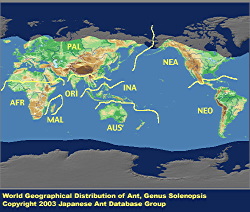
|
genus
|
Solenopsis
|
 |
Japanese Name
|
Tofushi-ari-zoku
|
Original Reference
|
|
Westwood, J.O. (1840b) Observations on the genus Typhlopone, with descriptions of several exotic species of ants. Annals and Magazine of Natural History 6: 81-89.
|
Synonym
|
|
Diplorhoptrum (Baroni-Urbani, 1968)
|
Description
|
|
Small to medium sized ants: total length of workers around 1 - 9 mm. Worker caste monomorphic or polymorphic. Antennae 10-segmented, the apical 2 segments forming a distinct club. Eyes small to medium in size. Mandibles each with 4 or 5 teeth. Palpal formula 1:2 or 2:2. Clypeus with a pair of longitudinal carinae, its anterior margin with a distinct medial seta. Dorsum of mesosoma horizontal in profile; metanotal groove distinct. Propodeal dorsum convex in profile; propodeum without spines. Petiole pedunculate, node relatively high. Subpetiolar process present.
|
|

|
Remarks
|
|
Baroni-Urbani(1968) elevated the former subgenus Solenopsis (Diplorhoptrum) to generic rank on the grounds of morphological differences in the male genitalia. Bolton (1987) recombined these taxa, treating their species as congeneric in Solenopsis. Solenopsis is distributed from the tropics to subarctic regions of the world, and comprises around 270 described species. The notorious agricultural pests known as "fire ants" are Solenopsis species. In the United States, S. invicta Buren, S. richteri Forel, and S. geminata (Fabricius) were originally introduced from South America and have subsequently extended their distributions in the southern states. They infest agricultural crops and domestic animals and carry disease-causing organisms. These ants inject alkaloid venom with their stings. This causes considerable pain, and sometimes induces serious allergic reactions in humans (Thompson, 1990). Solenopsis fugax (Latreille) is a tiny "thief ant", the nests of which are found close to the those of other ant species, which it can enter by minute connecting tunnels in order to steal food. Three Solenopsis species are known from Japan. S. geminata (Fabricius) was undoubtedly originally introduced onto Okinawa and Ie-jima in the Nansei Iwo-jima in the Volcano Islands. It is now very common on Iwo-jima.
|
References
|
|
- Baroni-Urbani, C. (1968). Ueber die eigenartige Morphologie der maenlichen Genitalien des Genus Diplorhoptrum Mayr (Hymenoptera Formicidae) und die taxonomischen Schlussfolgerungen. . Z. Morph. Tiere, 63, 63-74.
- Bolton, B. (1987). A review of the Solenopsis genus-group and revision of Afrotropical Monomorium Mayr (Hymenoptera: Formicidae). Bull. Br. Mus. Nat. Hist. (Ent.), 54, 263-452.
- Thompson, C. R. (1990). Ants that have pest status in the Unites States. . In R. K. Vander Meer, K. Jaffe & A. Cedeno, eds., ""Applied Myrmecology: A World Perspective"", 51-67. .
- Observations on the genus Typhlopone, with descriptions of several exotic species of ants. Annals and Magazine of Natural History 6: 81-89.
|
Editor
|
|
Original text by Mamoru Terayama. English translation by Mamoru Terayama, edited by Robert W. Taylor.
|
|